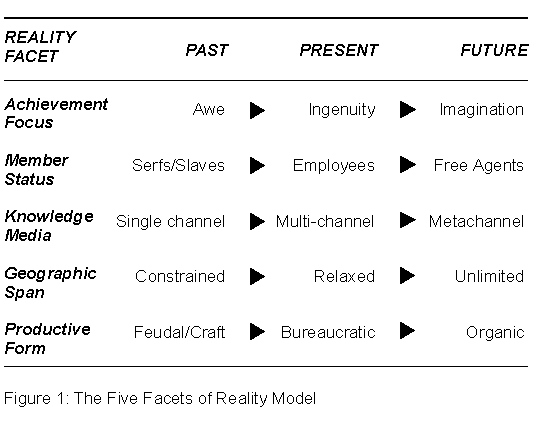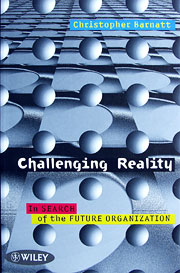 |
|
|
|
You are in: Future Mindsets : The Five Facets of Reality
The Five Facets of Reality
The Five Facets of Reality was introduced in Challenging Reality, the first book of my Future Trilogy, as a conceptual framework to assist in the study of radical technological, social and cultural transition. The model divides human history into "the past", "the present" and "the future", and then seeks to explore changes in five key "facets" of human and organizational existence over and between these periods of time. The most fundamental concept underpinning the model is that "reality" itself as a constraining force on human or organizational action is often nowhere near as permanent as we can get lulled or cajoled into believing. A key reason to look back to changes in certain facets of reality between the past and the present -- in addition to looking forward to changes from the present into the future -- is therefore to remind ourselves that many of the boundaries that govern our lives have not always been as they are today, and hence how they should not today be considered as "fixed" as we may get caught into believing. Past, Present and FutureIn the context of the Five Facets of Reality model, "the past" is taken to mean the entirety of pre-industrial human history spanning from the dawn of the earliest empires of antiquity right up until the mid- to late-19th century. "The present" then encompasses the heyday era of industrial mass production from the mid- to late-19th century to roughly the present day. "The Future" subsequently commences where the present ends. The segmentation of human history within the Five Facets framework is roughly in line with that used within other three-phase models of step change. For example, renowned futurist Alvin Toffler suggested that significant watersheds may be identified between a mass-agricultural "First Wave" and an industrial "Second Wave", and then between the Second Wave and a post-industrial "Third Wave" or "Information Age". Similarly, Michael Piore and Charles Sabel have labelled the periods of transition between three such ages or waves as the First and Second "Industrial Divides".  As illustrated above in Figure 1, the five "facets of reality" distinguished within the Five Facets of Reality framework -- and for which a distinct past-present-future progression may be charted -- are labelled "achievement focus", "member status", "knowledge media", "geographic span" and "productive form". The following sections now provide an explanation of each reality facet and its historical transition. Achievement FocusThe first reality facet of achievement focus is a measure of what is most valued or wondrous at any one point in time, and hence a reflection of that for which any particular society, culture or organization is most likely to be remembered. Most civilizations of past times can be considered to have had an achievement focus of "awe", and meaning that they were most inspired by the wonder of single, physical artworks or epic constructions such as the Pyramids of ancient Egypt, or the cathedrals of medieval Europe. In contrast, the late 19th century and the entire 20th century are more reasonably characterized by a mass faith in the cleverness or ingenuity of scientific and technological process. As a couple of examples, we remember Thomas Alva Edison for the creation of electric light bulbs, rather than for the construction of any individual filament lamp. Similarly the US Moonlandings Programme was a wondrous achievement focused upon a single act (a footfall on the Moon), rather than any particular individual rocket or space vehicle. However, as the future unfolds, what we most value are increasingly neither great physical artefacts nor momentous acts. Rather, it is ideas themselves -- or simply pure imagination -- that are becoming most wondrous. Indeed, with new technologies increasingly able to deliver almost any dream (let alone many nightmares), creativity is destined to become the most sought-after resource of the future. As this occurs, and as the pinnacle of what we most strive towards and value becomes signified not by wondrous monuments or great works of process, so our achievement focus may be considered to have evolved from the "what" of awe, through to the "how" of ingenuity, and towards the "why" of imagination. The progression of humanity's achievement focus across history is explored in my Archaeology of Wonder video. Member StatusThe reality facet of member status provides a measure of the type of work role -- or "work/command relationship" -- held by the majority of people within their society, culture or organization. In the past, many a dominant member status was based on the ownership of serfs or slaves who had no rights and no freedoms. As capitalism and industrialization spread, the dominant member status then progressed to involve employees paid to fulfil organizational roles, and who came to possess many rights if still few freedoms. However, if current labour market transitions continue, future organizations are likely to demand a great many lone "free agent" individuals from whom they can acquire services often via relatively transitory online connection. Such workers will be increasingly free to organize their own lives. However, as a consequence, they will enjoy few (if any) traditional employment rights and little job security. Knowledge MediaSince early humans formed tribes, the means used to replicate ideas have utilized an increasingly-wide range of communications forms. The reality facet of knowledge media may therefore be said to have progressed from the single channel media of the past, to the multi-channel "multimedia" of the 20th century, and into today's just emerging age of a ubiquitous, metachannel knowledge media -- or "metamedia" -- and in which text, still images, audio and video are all seamlessly integrated into synthetically-deliverable human experiences. The incredible evolution of knowledge media began with the birth of language itself. Next came the development of writing and printing. Across the 20th century, the telephone, sound recording, photography, movies, television, and computer networks were then invented to permit multiple or "multimedia" knowledge replication. Today, as computers are used more and more "interpersonally'", so cloud computing, virtual reality and augmented reality (wherein virtual reality is visually overlaid onto the physical world) all look set to evolve knowledge storage and transmission one stage further, to the extent that we will increasingly be able to work, play and trade with the metamedia of synthetic, human experiences. Geographic SpanThe fourth reality facet of Geographic Span concerns the physical area across which any society or organization may achieve influence or even dominance. Partially as a result of knowledge media transformation, this measure has widened across history from constrained regions with regional or national trade, and to the more geographically-relaxed state-of-affairs of much of the 20th century with the rise of international trade. Into the future, a geographic span of "unlimited" already perhaps best describes the effectively unbounded geographic limits of the most powerful societies and organizations. It also serves to remind us that our geographic span is set to extend beyond our first planet as, for example, developments accrue in areas such space tourism and the mining of new nuclear fuels on the Moon. In order to explore the above progression, Challenging Reality commences its study of geographic span with an explanation of the Second Law of Thermodynamics. This certainty of physics condemns all isolated communities to decay unless they seek resources further afield. For this reason, early empires (such as those of Ancient Egypt) flourished in regions with networks of natural waterways that enabled easy trade and transportation, and where metals and other mineral resources were within easy reach. As time went on, sea-faring nations subsequently came to dominate the world. Indeed, it was not until the arrival of railways, steamships -- and then automobiles -- that the majority ceased to be immobile. Sadly, such mobility was initially experienced by many during the first global events of the two world wars. Post-1945, the Cold War held back the great technological potential for globalization. Indeed, only with the fall of communism and the rise of global causes in the 1980s did any sense of global citizenship begin to surface. In particular, the popular uptake of the Internet played a significant role in permitting the emergence of today's "global village". However, globalism is already leading to isolation, a loss of individual identity, and mass-cultural homogeneity as mighty organizations peddle global products. Into the future, the "superorganism" of humanity will also need fresh resources. Policies to help "defeat" climate change and resource depletion may be both commendable and increasingly essential in the short- and medium-term. However, they in no way represent a long-term solution for the survival of the human race. Rather, just as our ancestors shrunk the Earth with ships and planes in search of new lands and resources, so the need is increasingly pressing for the development of space travel technologies to shrink the wider frontier of the Solar System. Productive FormThe first four Facets of Reality effectively map changes in the environment faced, or to be faced, by any organization large or small. The fifth facet of "productive form" therefore brings the model to a close with an examination of the dominant structure of work and its organization past, present and future. In past times large-scale organizations were autocratic, if rare. They may therefore be categorized as having been largely feudal/craft based. Such productive forms proved viable until geographic spans and knowledge media started to broaden. However, as this took place in the late-19th century, mass hierarchies and middle-managers became essential to maintain organizational control. The dominant productive structure hence evolved to be that of a bureaucratic organizational machine. And for many decades of Western prosperity, such large-scale if slow-moving business entities proved to be highly effective indeed. However, since the 1980s, the "big is best", vertically-integrated logic of "Fordist" scale and bureaucratic control has come to be questioned within increasingly "hypercompetitive" markets. As a result, more flexible, organic organizational structures have started to become the norm for many companies seeking to remain competitive within cut-throat, time-challenged modern economies. Today, whole industries are being transformed as large, "black box" organizational monoliths are confronted by new "virtual" productive forms that increasingly leverage Internet developments such as cloud computing. With organizations transforming from hierarchies to organic networks and even clouds in the face of such radical transformation on all sides, so industry boundaries will fall, skillsets will become more generic, and mashups will come to dominate organizational construction. As a result, wide mental frameworks may now offer the best hope when trying to plan for long-term future success . . . Return to Future Mindsets. |
 The Five Facets of Reality model was introduced in my 1997 book Challenging Reality. |
|
|